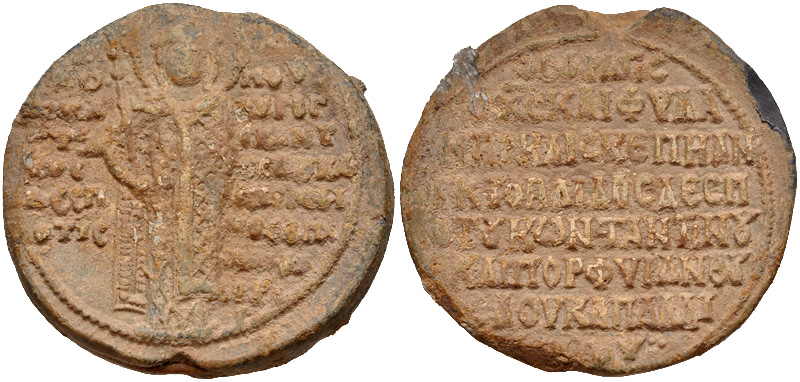Constantine Palaiologos (son of Andronikos II) on:
[Wikipedia]
[Google]
[Amazon]
 Constantine Doukas Komnenos Palaiologos ( gr, Κωνσταντῖνος Δούκας Κομνηνός Παλαιολόγος; 1278/81–1334/35) was a
Constantine Doukas Komnenos Palaiologos ( gr, Κωνσταντῖνος Δούκας Κομνηνός Παλαιολόγος; 1278/81–1334/35) was a
 Constantine Doukas Komnenos Palaiologos ( gr, Κωνσταντῖνος Δούκας Κομνηνός Παλαιολόγος; 1278/81–1334/35) was a
Constantine Doukas Komnenos Palaiologos ( gr, Κωνσταντῖνος Δούκας Κομνηνός Παλαιολόγος; 1278/81–1334/35) was a Byzantine
The Byzantine Empire, also referred to as the Eastern Roman Empire or Byzantium, was the continuation of the Roman Empire primarily in its eastern provinces during Late Antiquity and the Middle Ages, when its capital city was Constantin ...
prince of the Palaiologos
The House of Palaiologos ( Palaiologoi; grc-gre, Παλαιολόγος, pl. , female version Palaiologina; grc-gre, Παλαιολογίνα), also found in English-language literature as Palaeologus or Palaeologue, was a Byzantine Greek f ...
dynasty, who received the supreme title of Despot and served as provincial governor.
Constantine was the second son of Emperor Andronikos II Palaiologos (r. 1282–1328) and his first wife, Empress Anna of Hungary
Anna of HungaryIn Greek: Ἄννα; in Hungarian: Anna; in Croatian: Ana (Kingdom of Hungary, 1260–1281) was a Princess of Hungary and Croatia, daughter of Stephen V of Hungary and Elizabeth the Cuman. Anna was granddaughter of Béla IV of Hung ...
. He was born sometime between 1278 and 1281. As his father was already a reigning co-emperor alongside Michael VIII Palaiologos
Michael VIII Palaiologos or Palaeologus ( el, Μιχαὴλ Δούκας Ἄγγελος Κομνηνὸς Παλαιολόγος, Mikhaēl Doukas Angelos Komnēnos Palaiologos; 1224 – 11 December 1282) reigned as the co-emperor of the Empire ...
, he was styled a '' porphyrogennetos'' ("purple-born"), as attested on his seals. In 1294 he was named Despot, the highest court rank in the Byzantine Empire, on the occasion of his first marriage to Eudokia, the daughter of Theodore Mouzalon.
In 1305, he fought in the disastrous Battle of Apros against the Catalan Company
The Catalan Company or the Great Catalan Company (Spanish: ''Compañía Catalana'', Catalan: ''Gran Companyia Catalana'', Latin: ''Exercitus francorum'', ''Societas exercitus catalanorum'', ''Societas cathalanorum'', ''Magna Societas Catalanorum' ...
. In 1317, he intercepted his half-sister Simonida, the queen-consort of Serbia
Serbia (, ; Serbian: , , ), officially the Republic of Serbia (Serbian: , , ), is a landlocked country in Southeastern and Central Europe, situated at the crossroads of the Pannonian Basin and the Balkans. It shares land borders with Hung ...
, who wished to retire to a monastery after the death of her mother, Irene of Montferrat, and handed her over to the Serbs. At about this time he married a second time, again to a Eudokia, but both his marriages were childless. He had one illegitimate son, Michael Katharos. In 1319 he served as governor of Avlona Avlon, Avlona or Avlonas may refer to:
* Avlona, Albania, an English obsolete name of Vlorë, a seaport in Albania, still used in some other languages
* Avlona, Cyprus, a town in Cyprus
* settlements in Greece:
** Avlonas, Attica, a town in norther ...
, and in 1321–1322 as governor of Thessalonica
Thessaloniki (; el, Θεσσαλονίκη, , also known as Thessalonica (), Saloniki, or Salonica (), is the second-largest city in Greece, with over one million inhabitants in its metropolitan area, and the capital of the geographic region ...
. It was in this position that the outbreak of the Byzantine civil war of 1321–1328
The Byzantine civil war of 1321–1328 was a series of conflicts fought in the 1320s between the Byzantine emperor Andronikos II Palaiologos and his grandson Andronikos III Palaiologos over control of the Byzantine Empire.
Prelude to the civil wa ...
found him; in 1322 he was imprisoned by his nephew, Andronikos III Palaiologos
, image = Andronikos_III_Palaiologos.jpg
, caption = 14th-century miniature.Stuttgart, Württembergische Landesbibliothek.
, succession = Byzantine emperor
, reign = 24 May 1328 – 15 June 1341
, coronation ...
, at Didymoteichon
Didymoteicho ( el, Διδυμότειχο, Didymóteicho ) is a city located on the eastern edge of the Evros regional unit of Eastern Macedonia and Thrace, in northeastern Greece. It is the seat of the municipality of the same name. The to ...
. Constantine then became a monk, under the monastic name
A religious name is a type of given name bestowed for a religious purposes, and which is generally used in such contexts.
Christianity
Catholic Church Baptismal name
In baptism, Catholics are given a Christian name, which should not be "foreign ...
Kallistos. He died in 1334/35.
Sources
* 13th-century births 1330s deaths 14th-century Byzantine people 13th-century Byzantine people Byzantine governors of Thessalonica Byzantine prisoners and detainees Constantine Porphyrogennetoi Eastern Orthodox monks Despots (court title) Sons of Byzantine emperors {{Byzantine-bio-stub